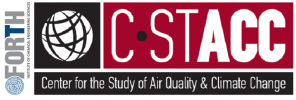|
|
The primary aim of ACCENT-Plus is to foster the integration of the atmospheric science community in Europe, continuing a long lasting process that has been initiated in the 90’s by the EUROTRAC I and II projects and later by the ACCENT Network of Excellence. ACCENT-Plus is inviting all research institutions active in atmospheric science to become Associates |
|
|
Founded in 1901, NIST is a non-regulatory federal agency within the U.S. Department of Commerce. NIST's mission is to promote U.S. innovation and industrial competitiveness by advancing measurement science, standards, and technology in ways that enhance economic security and improve our quality of life. |
|
|
The Automated Mass Spectral Deconvolution and Identification System (AMDIS) is a computer program that extracts spectra for individual components in a GC/MS data file and identifies target compounds by matching these spectra against a reference library. It was developed at NIST with support from the United States Department of Defense and is freely available. |
 |
The Master Chemical Mechanism (MCM) is a near-explicit chemical mechanism which describes the detailed gas-phase chemical processes involved in the tropospheric degradation of a series of primary emitted volatile organic compounds (VOCs). Currently, the degradation of methane and 142 non-methane VOCs is represented.
|
|
|
NOAA is an agency that enriches life through science. From daily weather forecasts, severe storm warnings and climate monitoring to fisheries management, coastal restoration and supporting marine commerce, NOAA’s products and services support economic vitality and affect more than one-third of America’s gross domestic product. The HYSPLIT (HYbrid Single-Particle Lagrangian Integrated Trajectory) model is a complete system for computing simple air parcel trajectories to complex dispersion and deposition simulations. The initial development was a result of a joint effort between NOAA and Australia's Bureau of Meteorology. |
|
|
The U.S. Environmental Protection Agency (EPA or sometimes USEPA) is an agency of the federal government of the United States charged with protecting human health and the environment, by writing and enforcing regulations based on laws passed by Congress. The Plan also introduces the following five cross-cutting fundamental strategies which set clear expectations for changing the way EPA does business in achieving its results. The Chemical Mass Balance (CMB) Model EPA-CMBv8.2 is one of several receptor models that has been applied to air quality problems over the last two decades. Based on an effective-variance least squares method (EVLS), EPA has supported CMB as a regulatory planning tool through its approval of numerous State Implementation Plans (SIPs) which have a source apportionment component. EPA PMF is one of the receptor models that ORD has developed. The user provides a file of sample species concentrations and uncertainties which the model uses to calculate the number of sources types, profiles, relative contributions, and a time series of contributions. The algorithms used in EPA PMF model to compute profiles and contributions have been peer reviewed by leading scientists in the air quality management community and have been certified to be scientifically robust. |
|
|
Scopus is the largest abstract and citation database of peer-reviewed literature and quality web sources with smart tools to track, analyze and visualize research. It's designed to find the information scientists need. Quick, easy and comprehensive, Scopus provides superior support of the literature research process. |
|
|
Web of Science is an online academic citation index. It is designed for providing access to multiple databases, cross-disciplinary research, and in-depth exploration of specialized subfields within an academic or scientific discipline. Moreover, as a citation index, any cited paper will lead to any other literature (book, academic journal, proceedings, etc.) which currently, or in the past, cites this work. In addition, literature which shows the greatest impact in a field, or more than one discipline, can be selectively obtained. |
|
|
Monitoring Atmospheric Composition and Climate - is the current pre-operational atmospheric service of the European GMES programme. MACC provides data records on atmospheric composition for recent years, data for monitoring present conditions and forecasts of the distribution of key constituents for a few days ahead. MACC combines state-of-the-art atmospheric modelling with Earth observation data to provide information services covering European Air Quality, Global Atmospheric Composition, Climate, and UV and Solar Energy. |
|
|
The main goal of the National observatory of Athens is the analysis, the collection of data and the promotion of the research in the fields of the atmospheric environment, the space and the earths crust.
Meteo through the NOA provides real-time measurements as well as historical data from all the weather stations in the Greek area. |
|
|
EUSAAR (European Supersites for Atmospheric Aerosol Research) is an EU-funded I3 (Integrated Infrastructures Initiatives) project carried out in the framework of the specific research and technological development gramme "Structuring the European Research Area - Support for Research Infrastructures". The objective of EUSAAR is the integration of measurements of atmospheric aerosol properties performed in a distributed network of 20 high quality European ground-based stations. This integration contributes to a sustainable reliable operational service in support of policy issues on air quality, long-range transport of pollutants and climate change. |
|
|
The Time-of-Flight Aerosol Mass Spectrometer (ToF-AMS) is a second generation instrument for the real-time measurement of size-resolved aerosol chemical composition. The ToF-AMS is commercialized by Aerodyne Research, and was developed by Aerodyne in collaboration with Tofwerk AG, the Jimenez Group at the University of Colorado, the Borrmann Group at the Max Planck Institute for Chemistry, and the Coe Group at the University of Manchester. It is based on the highly successful design of the first generation quadrupole-based system, the Q-AMS. The ToF-AMS differs from the Q-AMS in the replacement of the quadrupole mass filter, with a custom designed Tofwerk time-of-flight mass Spectrometer. |
|
|
The Pan-European Gas-AeroSOls-climate interaction Study (PEGASOS). This European large scale integrating project brings together most of the leading European research groups, with state-of the-art observational and modeling facilities, to quantify the magnitude of regional to global feedbacks between atmospheric chemistry and a changing climate and to reduce the corresponding uncertainty of the major ones. Also PEGASOS aim is to identify mitigation strategies and policies to improve air quality while limiting their impact on climate change. |
|
|
Global Weather Patterns (Past and future) Wind map and weather forecast for kiters, surfers, pilots, sailors and anyone else. Worldwide animated weather map, with easy to use overlays and precise spot forecast. METAR, TAF and NOTAMs for any airport in the World. |
|
Master Chemical Mechanism (MCM) The Master Chemical Mechanism (MCM) is a near-explicit chemical mechanism which describes the detailed gas-phase chemical processes involved in the tropospheric degradation of a series of primary emitted volatile organic compounds (VOCs). Currently, the degradation of methane and 142 non-methane VOCs is represented. |
|
|
|
Carnegie Mellon University has been a birthplace of innovation since its founding in 1900. Today, CMU is a global leader bringing groundbreaking ideas to market and creating successful startup businesses. Our award winning faculty are renowned for working closely with students to solve major scientific, technological and societal challenges. |













